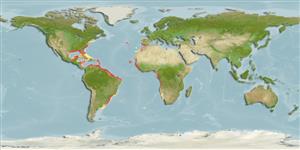Environment: milieu / climate zone / depth range / distribution range
Ecología
marino; salobre; rango de profundidad 10 - 180 m (Ref. 27121). Subtropical; 44°N - 40°S, 97°W - 16°E
Western Atlantic: New England, USA and Bermuda to Argentina (Ref. 47377). Eastern Atlantic: Mauritania to Namibia (Ref. 27121). Southwest Atlantic: Sergipe, Brazil (Ref. 118626).
Tamaño / Peso / Age
Maturity: Lm ? range ? - ? cm
Max length : 100.0 cm TL macho / no sexado; (Ref. 3694); common length : 60.0 cm TL macho / no sexado; (Ref. 3694); peso máximo publicado: 4.9 kg (Ref. 40637)
Espinas dorsales (total): 0; Radios blandos dorsales (total): 13-15; Espinas anales 0; Radios blandos anales: 12 - 13
Inhabits inshore and near-shore areas, over sand or mud bottoms. Usually found alone or in small, loose aggregates. Adults are pelagic, but near continental margins; young are commonly found on coastal and offshore banks (Ref. 7251). Feeds on fish and shrimps (Ref. 28587). Minimum depth from Ref. 26912. Its flesh is very delicate; nevertheless, in certain region like the Pacific and the Indian Ocean, it is toxic (particularly the skin and the viscera) (Ref. 5377). Poisonous, should not be eaten (Ref. 36731).
Life cycle and mating behavior
Madurez | Reproducción | Puesta | Huevos | Fecundidad | Larva
Shipp, R.L., 1990. Tetraodontidae. p. 1069-1072. In J.C. Quero, J.C. Hureau, C. Karrer, A. Post and L. Saldanha (eds.) Check-list of the fishes of the eastern tropical Atlantic (CLOFETA). JNICT, Lisbon; SEI, Paris; and UNESCO, Paris. Vol. 2. (Ref. 7464)
IUCN Red List Status (Ref. 130435)
Human uses
Pesquerías: escaso valor comercial
Más información
ReferenciasAcuiculturaPerfil de acuiculturaRazasGenéticaElectrophoresesheritabilidadEnfermedadesProcesamientoNutrientsMass conversion
Herramientas
Special reports
Download XML
Fuentes de Internet
Estimates based on models
Preferred temperature (Ref.
123201): 16.2 - 27.3, mean 23.2 °C (based on 373 cells).
Phylogenetic diversity index (Ref.
82804): PD
50 = 0.5005 [Uniqueness, from 0.5 = low to 2.0 = high].
Bayesian length-weight: a=0.02042 (0.01592 - 0.02619), b=2.85 (2.81 - 2.89), in cm total length, based on LWR estimates for this species (Ref.
93245).
Nivel trófico (Ref.
69278): 4.0 ±0.69 se; based on food items.
Resiliencia (Ref.
120179): Medio, población duplicada en un tiempo mínimo de 1.4-4.4 años (Preliminary K or Fecundity.).
Fishing Vulnerability (Ref.
59153): High vulnerability (60 of 100).
Nutrients (Ref.
124155): Calcium = 36.6 [14.9, 98.0] mg/100g; Iron = 1.01 [0.54, 2.12] mg/100g; Protein = 19.5 [17.4, 21.9] %; Omega3 = 0.429 [0.191, 0.878] g/100g; Selenium = 28.5 [14.1, 56.2] μg/100g; VitaminA = 9.02 [3.40, 24.30] μg/100g; Zinc = 0.688 [0.482, 0.972] mg/100g (wet weight);
